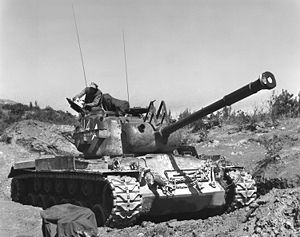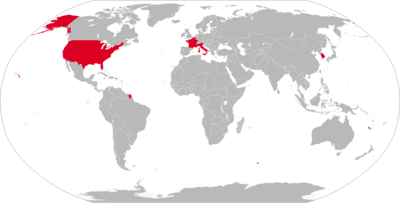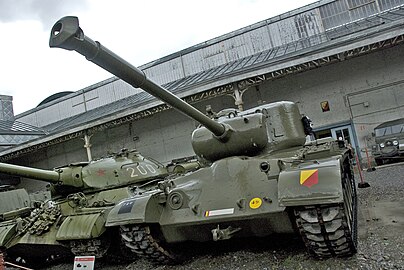
The M4 Sherman, officially medium tank, M4, was the most widely used medium tank by the United States and Western Allies in World War II. The M4 Sherman proved to be reliable, relatively cheap to produce, and available in great numbers. It was also the basis of several other armored fighting vehicles including self-propelled artillery, tank destroyers, and armored recovery vehicles. Tens of thousands were distributed through the Lend-Lease program to the British Commonwealth, Soviet Union, and other Allied Nations. The tank was named by the British after the American Civil War General William Tecumseh Sherman.

The M26 Pershing is a heavy tank, later designated as a medium tank, formerly used by the United States Army. It was used in the last months of World War II during the Invasion of Germany and extensively during the Korean War. The tank was named after General of the Armies John J. Pershing, who led the American Expeditionary Force in Europe in World War I.

The M48 Patton is an American first-generation main battle tank (MBT) introduced in February 1952, being designated as the 90mm Gun Tank: M48. It was designed as a replacement for the M26 Pershing, M4 Sherman, M46 and M47 Patton tanks, and was the main battle tank of the U.S. Army and U.S. Marine Corps in the Vietnam War. Nearly 12,000 M48s were built, mainly by Chrysler and American Locomotive Company, from 1952 to 1961. The M48 Patton was the first U.S. medium gun tank with a four-man crew, featuring a centerline driver's compartment and no bow machine gunner. As with nearly all new armored vehicles it had a wide variety of suspension systems, cupola styles, power packs, fenders and other details among individual tanks.

The M47 Patton was an American Medium tank, a development of the M46 Patton mounting an updated turret, and was in turn further developed as the M48 Patton. It was the second American tank to be named after General George S. Patton, commander of the U.S. Third Army during World War II and one of the earliest American advocates of tanks in battle.
Tank development both evolved considerably from World War II and played a key role during the Cold War (1945–1990). The period pitted the nations of the Eastern Bloc and the North Atlantic Treaty Organization (NATO) against each other.

This article deals with Sherman tanks extensive use around the world after World War II and catalogues foreign post–World War II use and conversions of Sherman tanks and variants based on the Sherman chassis.

The M74 tank recovery vehicle (M74) was an engineer vehicle used by the U.S. Army in the 1950s. It was designed to cope with the heavier weights of the M26 Pershing and M47 Patton. It could also be suitable for light dozing, since it had a hydraulic, front-mounted spade. 1126 were produced by Bowen-McLaughlin-York by converting M4A3 Sherman tanks starting in 1954. From 1956, 60 M32B3A1s were converted by Rock Island Arsenal until 1958.

The United States has produced tanks since their inception in World War I, up until the present day. While there were several American experiments in tank design, the first American tanks to see service were copies of French light tanks and a joint heavy tank design with the United Kingdom.

This article deals with the history and development of American tanks from the end of World War II and during the Cold War.

After World War II the Italian Army had two units named "Centauro": from 1952 to 1986 the Armored Division "Centauro" and from 1986 to 2002 the Armored Brigade "Centauro". Both units were successor to the World War II era 131st Armored Division "Centauro". The units' name came from the mythological race of half human-half horse creatures named Centaurs.

The 132nd Armored Brigade "Ariete" is currently the only active armored brigade of the Italian Army. Its core units are tank and Bersaglieri regiments. The brigade's headquarters is in Pordenone, and most of its units are based in the North-East of Italy. The brigade's name comes from the battering ram. The brigade draws much of its historical traditions from the 132nd Armored Division "Ariete," which fought in the Western Desert Campaign of World War II. In 1948, the Ariete was reconstituted as a division and remained active until 1986. Today the brigade is part of the Division "Vittorio Veneto".

The history and development of the tank in the South Korea spans the period from their adoption after World War II with the foundation of the South Korean army, into the Cold War and the present. Over this period Korea has moved from being an operator of United States designed and produced tanks to being the designer and manufacturer of tanks in its own right.

The history and development of the tank in North Korea spans the period from their adoption after World War II with the foundation of the Korean People's Army, into the Cold War and the present. Over this period North Korea has moved from being an operator of Soviet-designed and produced tanks to being the manufacturer of its own tanks.
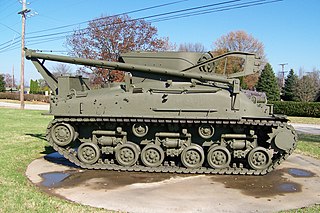
The M32 tank recovery vehicle was an armored recovery vehicle (ARV) used during World War II and the Korean War by the United States, and was based on the chassis of the M4 Sherman medium tank. During World War II, the British also used several hundred M32s, which were obtained through Lend-Lease in 1944. The first four prototypes were produced in January 1943, labeled T5, T5E1, T5E2, T5E3, and T5E4. After a series of tests at the Aberdeen Proving Grounds, the prototypes were approved as M32, M32E1, M32E2, M32E3, and M32E4. However, the M32E4 never entered production. There were also variants that had horizontal volute spring suspension (HVSS), which were demarcated by the suffix "A1" after the model number.

The 31st Tank Regiment is an inactive tank regiment of the Italian Army, which was based in Lecce in Apulia and last operationally assigned to the Mechanized Brigade "Pinerolo". The regiment was formed in July 1937 by the Royal Italian Army and assigned to the I Armored Brigade. In April 1939, the regiment moved from Siena to Tirana in occupied Albania. In winter 1940-41 the regiment fought in the Greco-Italian War and in 1941 it participated in the Invasion of Yugoslavia. In November 1942, the regiment was sent to Libya, where it fought in the Western Desert campaign and then in the Tunisian campaign. In April 1943 the regiment was disbanded due to the heavy losses it had suffered in the Battle of El Guettar. The regiment was immediately reformed in Italy, but it saw no further action, until German forces disbanded it after the announcement of the Armistice of Cassibile on 8 September 1943.

The 132nd Tank Regiment is a tank regiment of the Italian Army based in Cordenons in Friuli-Venezia Giulia. The regiment is equipped with Ariete main battle tanks and assigned to the 132nd Armored Brigade "Ariete". The 132nd Tank Infantry Regiment was formed in June 1941 by the Royal Italian Army and assigned to the 132nd Armored Division "Ariete", which was fighting in the Western Desert campaign in Libya and Egypt. In September 1941, the regiment arrived at the front and in November and December 1941 the regiment fought in Operation Crusader. In 1942 the regiment fought in the Battle of Gazala, Battle of Bir Hakeim, First Battle of El Alamein, Battle of Alam el Halfa, and Second Battle of El Alamein. During the latter battle the regiment was destroyed. For its conduct in North Africa the regiment was awarded Italy's highest military honor the Gold Medal of Military Valor.

The 62nd Armored Battalion "M.O. Jero" is an inactive armored battalion of the Italian Army, which was based in Catania in Sicily and last operationally assigned to the Motorized Brigade "Aosta". The unit's lineage traces back to the World War II LXII Tank Battalion L, which in 1940 participated in the Italian invasion of Egypt. On 5 January 1940, the battalion was destroyed in the Battle of Bardia. In 1960 the battalion was reformed and assigned to the Infantry Division "Aosta". In 1975 the battalion was renamed 62nd Armored Battalion "M.O. Jero". In 1992 the battalion was disbanded and its flag transferred to the Shrine of the Flags in the Vittoriano in Rome.
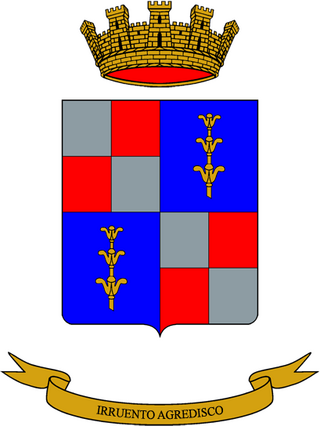
The 60th Tank Battalion "M.O. Locatelli" is an inactive tank battalion of the Italian Army, which was based in Altamura in Apulia and last operationally assigned to the Mechanized Brigade "Pinerolo". The unit's lineage traces back to the World War II LX Tank Battalion L, which in 1940-41 fought in the Western Desert campaign and was destroyed during Operation Compass in the Battle of Beda Fomm. In 1960 the battalion was reformed and assigned to the Infantry Division "Avellino". In 1965 the battalion was transferred to the Infantry Brigade "Pinerolo". In 1975 the battalion was renamed 60th Armored Battalion "M.O. Locatelli" and in 1979 the battalion was renamed 60th Tank Battalion "M.O. Locatelli". In September 1992 the battalion entered the 60th Tank Regiment "M.O. Locatelli", but already one month later the regiment was renamed 133rd Tank Regiment and the flag of the 60th Tank Regiment "M.O. Locatelli" was transferred to the Shrine of the Flags in the Vittoriano in Rome.
